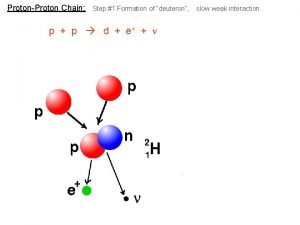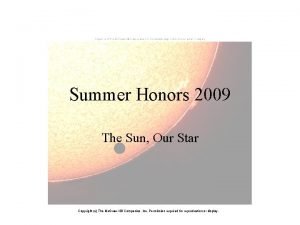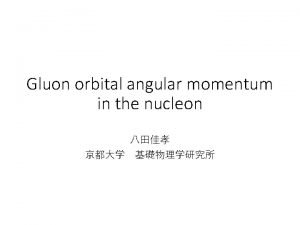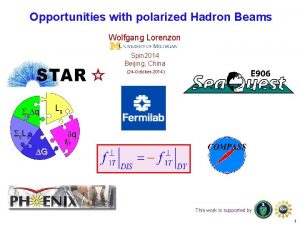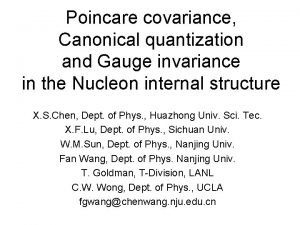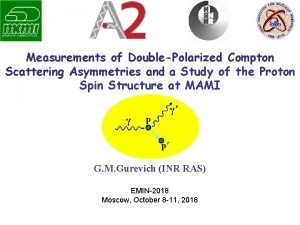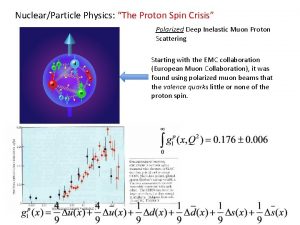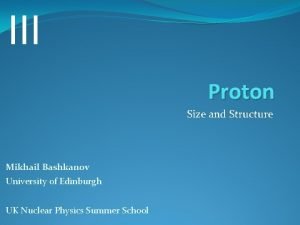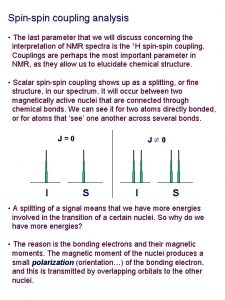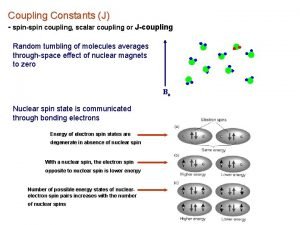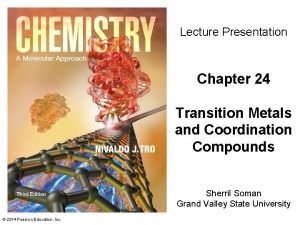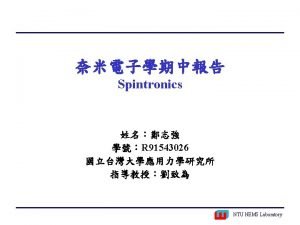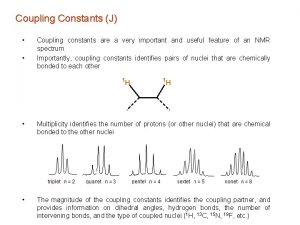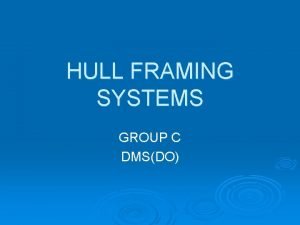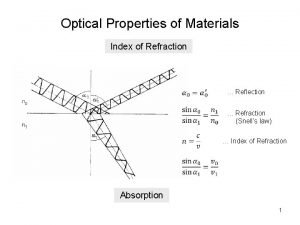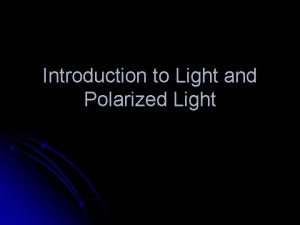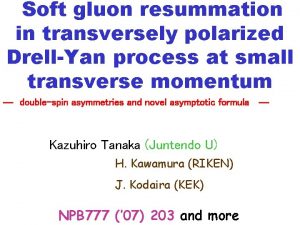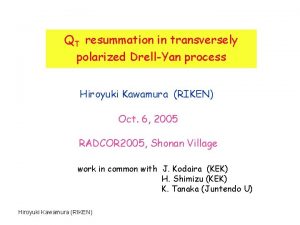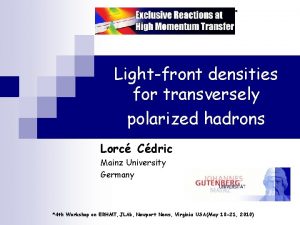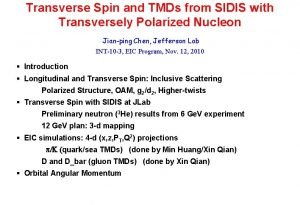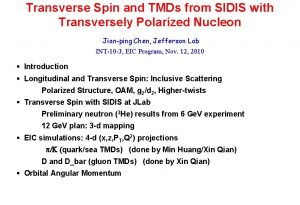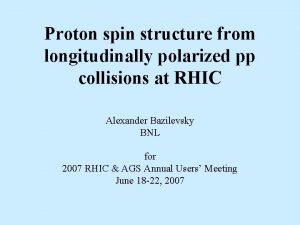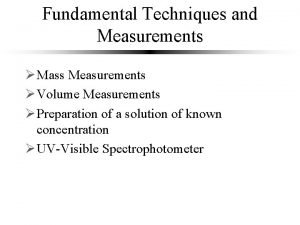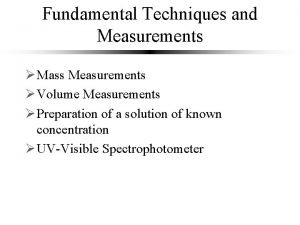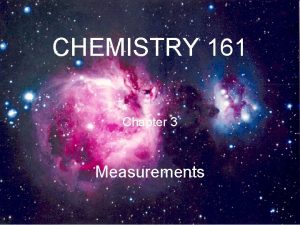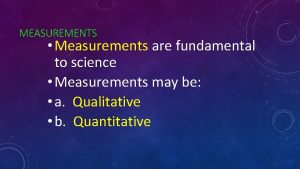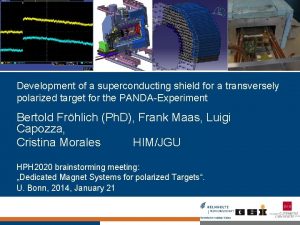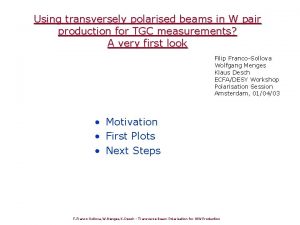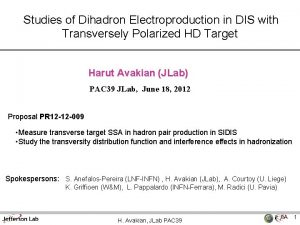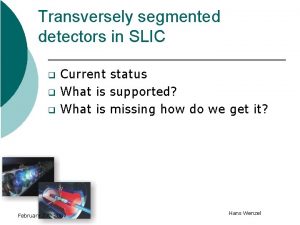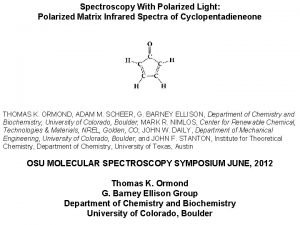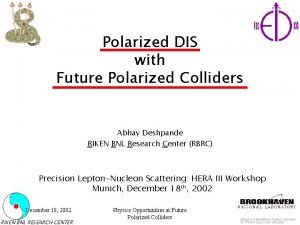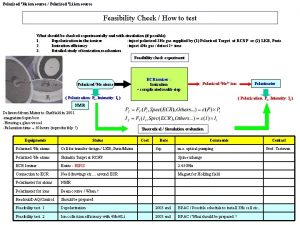Transversely Polarized Proton Spin Measurements in Polarized pp



















- Slides: 19

Transversely Polarized Proton Spin Measurements in Polarized p+p Collisions in Mickey Chiu

Transverse Single Spin Asymmetries Definition: where p is the 4 -momentum of a particle (hadron, jet, photon, etc. . . ) Experimentally, there a variety of (~equivalent) ways this can be measured. 1. Yield difference between up/down proton in a single detector Left Right This is susceptible to Rel. Luminosity differences 2. Or, take the left-right difference between 2 detectors This is susceptible to detector Relative Acceptance differences 3. Or, take the cross geometric mean (square-root formula) Mostly insensitive to Relative Luminosity and Detector Acceptance differences 2

Transverse Proton Spin Physics Polarized parton distribution functions quark helicity distribution – known gluon helicity distribution – poorly known transversity distribution – unknown Naïve LO, Leading Twist, p. QCD Result E 704 Helicity violation term due to finite quark masses 3

Transverse Proton Spin Physics • Various possible explanations have been proposed to explain these asymmetries • Transversity x Spin-dep fragmentation (e. g. , Collins effect), • Intrinsic-k. T in proton (Transverse Momentum Dep Functions) , • Eg, Sivers Function • Perturbative LO Twist-3 Calculations (Qiu-Sterman, Efremov, Koike) • These calculations have been related to the Sivers function A Unified picture for single transverse-spin asymmetries in hard processes, Ji, Qiu, Vogelsang, Yuan PRL 97: 082002, 2006 • Or some combination of the above • Caveat: The theory is still being actively worked out Anim. courtesy J. Kruhwel, JLAB 4

PHENIX at RHIC Spin STAR MPC PHENIX Transversely Polarized p+p Data Set Run 02 Run 05 Run 06 s (Ge. V/c 2) 200 200 62. 4 Ldt (pb-1) 0. 15 2. 7 0. 02 <P> 0. 15 0. 47 0. 50 P 2 L 0. 0034 0. 033 0. 87 0. 05 • Central Arm Tracking | | < 0. 35, x. F ~ 0 • Drift Chamber (DC) • momentum measurement • Pad Chambers (PC) • pattern recognition, 3 d space point • Time Expansion Chamber (TEC) • additional resolution at high pt • Central Arm Calorimetry • Pb. Gl and Pb. Sc • Very Fine Granularity • Tower x ~ 0. 01 x 0. 01 • Trigger • Central Arm Particle Id • RICH • electron/hadron separation • TOF • /K/p identification • Global Detectors (Luminosity, Trigger) • BBC 3. 0 < | | < 3. 9 • Quartz Cherenkov Radiators • ZDC/SMD (Local Polarimeter) • Forward Hadron Calorimeter • Forward Calorimetry 3. 1 < | | < 3. 7 • MPC • Pb. WO 4 Crystal • Forward Muon Arms 1. 2 < | | < 2. 4 5

Single Spin Asymmetries at x. F=0 PRL 95, 202001 (2005) p +p 0+X at s=200 Ge. V/c 2 PLB 603, 173 (2004) process contribution to 0, =0, s=200 Ge. V • AN for both charged hadrons and neutral pions consistent with zero at midrapidity. • More statistics needed to map out p. T x g/q dependence • If large asymmetries at forward rapidities is from valence quark motion, does asymmetry at mid-rapidity appear at high enough x. T = 2 p. T/ s? • Mid-rapidity data constrains magnitude of gluon Sivers function 6

Constraints on Gluon Sivers? Anselmino et al, PRD 74: 094011, 2006 PHENIX 0, PRL 95, 202001 (2005) • LO QCD Transverse Momentum Dependent parton scattering calculations • Cyan: Gluon Sivers Function at positivity bound, no sea quark Sivers • Thick Red: Gluon Sivers parameterized to be 1 sigma from PHENIX 0 AN • Blue: Asymmetry from Sea quark Sivers at positivity bound • Green: Asymmetry from Gluon Sivers for case of sea quark at positivity bound 7

0 AN at High x. F p +p 0+X at s=62. 4 Ge. V/c 2 3. 0< <4. 0 PLB 603, 173 (2004) process contribution to 0, =3. 3, s=200 Ge. V • Large asymmetries at forward x. F • Valence quark effect? • x. F, p. T, s, and dependence provide quantitative tests for theories 8

RHIC Forward Pion AN at 62. 4 Ge. V E 704, 19. 4 Ge. V, PLB 261, (1991) 201 PH EN IX an d Br ah m s Pr el im in ar y • Brahms Spectrometer at “ 2. 3 ” and “ 3. 0 ” setting < > = 3. 44, comparable to PHENIX all eta • Qualitatively similar behavior to E 704 data: pi 0 is positive and between pi+ and pi-, and roughly similar magnitude: AN(pi+)/AN(pi 0) ~ 25 -50% • Flavor dependence of identified pion asymmetries can help to distinguish between effects • Kouvaris, Qiu, Vogelsang, Yuan, PRD 74: 114013, 2006 • Twist-3 calculation for pions for pion exactly at 3. 3 • Derived from fits to E 704 data at s=19. 4 Ge. V and then extrapolated to 62. 4 and 200 Ge. V • Only qualitative agreement at the moment. Must be very careful in comparisons (between expt’s and theories) that kinematics are matched, since AN is a strong function of p. T and x. F. 9

Comparison to 0 at s = 200 Ge. V/c 2 STAR • Trend with seems to disagree with STAR result, but is consistent with theoretical predictions. • This might just be due to the different collision energy and p. T coverage 10

Kinematic Cuts and AN Phys. Rev. D 74: 114013, 2006. 5 <3. a t e 5 >3. eta • Mean AN is measured to be lower for p. T>1, even though mean x. F is higher for this p. T bin, and higher x. F implies higher asymmetry • This implies that AN is dropping with pt for a given x. F slice • The cut, for a given x. F slice, splits that slice into high pt and low pt, with the lower eta selecting higher pt • This implies that AN at lower should be smaller, consistent with predictions of PRD 74: 114013 • However, at 62. 4 Ge. V the p. T are low (p. QCD invalid? ) • Cross-section is being analyzed now 11

J/ AN Quark Sivers = 0 Gluon Sivers = Max Quark Sivers = Max Gluon Sivers = 0 • Bkg from like-sign and sidebands • J/ Production is gluon dominated at RHIC • Production thought to be not well understood • NRQCD describes data well? • Gluon has zero transversity • Collins Effect suppressed • Gluon Sivers Dominant • Anselmino et al, PRD 70: 074025 (hep-ph/0407100) • Calculation for Open Charm, NOT J/ Submitted to PRL 12

Summary • Much new data coming from transversely polarized proton interactions • p +p (RHIC), but also e+p SIDIS (Hermes, Compass, JLab), e+e- (Belle) • Along with new data on the helicity distribution of partons in the proton (gluon spin), transversely polarized proton collisions could add a wealth of new information on proton structure • Transversity, Orbital angular momentum? 1 -dimensional • GPD’s may be cleanest way to OAM • However, strongest asymmetries are in p +p • PHENIX has measured the transverse asymmetry of 0, h , and J/ , covering an x. F from 0 to 0. 6 (at two different collision energies). • There also sizable asymmetries from proton wave-function forward neutrons out to x. F ~ 1. * • In the future, we expect ~25% of the polarized PHENIX preliminary p+p running will be in the transverse mode • Lots more data coming • New upgrade detectors should significantly enhance physics reach • Nose Cone Calorimeter • Silicon Detectors (SVTX and FVTX) * See Poster by M. Togawa 13

Collaboration, 2006 University of São Paulo, Brazil Academia Sinica, Taipei 11529, China Institute of Atomic Energy (CIAE), Beijing, P. R. China Peking University, Beijing, P. R. China Charles University, Faculty of Mathematics and Physics, Ke Karlovu 3, 12116 Prague, Czech Republic Czech Technical University, Faculty of Nuclear Sciences and Physical Engineering, Brehova 7, 11519 Prague, Czech Republic Institute of Physics, Academy of Sciences of the Czech Republic, Na Slovance 2, 182 21 Prague, Czech Republic University of Jyvaskyla, P. O. Box 35, FI-40014 Jyvaskyla, Finland Laboratoire de Physique Corpusculaire (LPC), Universite de Clermont-Ferrand, F-63170 Aubiere, Clermont-Ferrand, France Dapnia, CEA Saclay, Bat. 703, F-91191 Gif-sur-Yvette, France IPN-Orsay, Universite Paris Sud, CNRS-IN 2 P 3, BP 1, F-91406 Orsay, France Laboratoire Leprince-Ringuet, Ecole Polytechnique, CNRS-IN 2 P 3, Route de Saclay, F 91128 Palaiseau, France SUBATECH, Ecòle des Mines at Nantes, F-44307 Nantes, France University of Muenster, Germany KFKI Research Institute for Particle and Nuclear Physics at the Hungarian Academy of Sciences (MTA KFKI RMKI), Budapest, Hungary Debrecen University, Debrecen, Hungary Eövös Loránd University (ELTE), Budapest, Hungary Banaras Hindu University, Banaras, India Bhabha Atomic Research Centre (BARC), Bombay, India Weizmann Institute, Rehovot 76100, Israel Center for Nuclear Study (CNS-Tokyo), University of Tokyo, Tanashi, Tokyo 188, Japan Hiroshima University, Higashi-Hiroshima 739, Japan KEK - High Energy Accelerator Research Organization, 1 -1 Oho, Tsukuba, Ibaraki 3050801, Japan Kyoto University, Kyoto, Japan Nagasaki Institute of Applied Science, Nagasaki-shi, Nagasaki, Japan RIKEN, The Institute of Physical and Chemical Research, Wako, Saitama 351 -0198, Japan RIKEN – BNL Research Center, Japan, located at BNL Physics Department, Rikkyo University, 3 -34 -1 Nishi-Ikebukuro, Toshima, Tokyo 171 -8501, Japan Tokyo Institute of Technology, Oh-okayama, Meguro, Tokyo 152 -8551, Japan University of Tsukuba, 1 -1 -1 Tennodai, Tsukuba-shi Ibaraki-ken 305 -8577, Japan Waseda University, Tokyo, Japan Cyclotron Application Laboratory, KAERI, Seoul, South Korea Ewha Womans University, Seoul, Korea Kangnung National University, Kangnung 210 -702, South Korea University, Seoul 136 -701, Korea Myong Ji University, Yongin City 449 -728, Korea System Electronics Laboratory, Seoul National University, Seoul, South Korea Yonsei University, Seoul 120 -749, Korea IHEP (Protvino), State Research Center of Russian Federation , Protvino 142281, Russia Joint Institute for Nuclear Research (JINR-Dubna), Dubna, Russia Kurchatov Institute, Moscow, Russia PNPI, Petersburg Nuclear Physics Institute, Gatchina, Leningrad region 188300, Russia 14 Countries; 68 Institutions; 550 Participants* Abilene Christian University, Abilene, Texas, USA Brookhaven National Laboratory (BNL), Chemistry Dept. , Upton, NY 11973, USA Brookhaven National Laboratory (BNL), Collider Accelerator Dept. , Upton, NY 11973, USA Brookhaven National Laboratory (BNL), Physics Dept. , Upton, NY 11973, USA University of California - Riverside (UCR), Riverside, CA 92521, USA University of Colorado, Boulder, CO, USA Columbia University, Nevis Laboratories, Irvington, NY 10533, USA Florida Institute of Technology, Melbourne, FL 32901, USA Florida State University (FSU), Tallahassee, FL 32306, USA Georgia State University (GSU), Atlanta, GA 30303, USA University of Illinois Urbana-Champaign, IL, USA Iowa State University (ISU) and Ames Laboratory, Ames, IA 50011, USA Los Alamos National Laboratory (LANL), Los Alamos, NM 87545, USA Lawrence Livermore National Laboratory (LLNL), Livermore, CA 94550, USA University of Maryland, College Park, MD 20742, USA Department of Physics, University of Massachusetts, Amherst, MA 01003 -9337, USA Old Dominion University, Norfolk, VA 23529, USA University of New Mexico, Albuquerque, New Mexico, USA New Mexico State University, Las Cruces, New Mexico, USA Department of Chemistry, State University of New York at Stony Brook (USB), Stony Brook, NY 11794, USA Department of Physics and Astronomy, State University of New York at Stony Brook (USB), Stony Brook, NY 11794, USA *as of July 2006 Oak Ridge National Laboratory (ORNL), Oak Ridge, TN 37831, USA University of Tennessee (UT), Knoxville, TN 37996, USA and growing Vanderbilt University, Nashville, TN 37235, USA 14

15

Run 02 Inclusive AN Systematic Errors In addition to calculating the asymmetry using more than one method, potential systematic errors have been investigated in the following ways: • Measured asymmetry of background – Immediately outside the 0 mass peak – In the mass region between the 0 and the • Compared independent measurements for two polarized beams • Compared results for left and right sides of detector • Compared minimum bias and triggered data samples • Examined fill-by-fill consistency of asymmetry values • Used the “bunch shuffling” technique to check for systematic errors – Randomly reassign the spin direction to each bunch in the beam – Recalculate the asymmetry – Repeat many times (1000) to produce a “shuffled” asymmetry distribution centered around zero – Compare width of shuffled distribution to statistical error on physics asymmetry 16

Muon Piston Calorimeter Performance • Shower Reconstruction Using Shower Shape Fits All Pairs Mixed Events Background subtracted • Energy Scale Set by MIP • In Noisy Towers, Used Tower Spectrum MIP Peak • Photon Pair Cuts • Pair Energy > 8 Ge. V • Asymmetry |E 1 -E 2|/|E 1+E 2| < 0. 6 • Noisy Towers (up to 25% of MPC) Excluded • Width ~ 20 Me. V • Confirmed with 0, peaks 17

MPC N Fit Examples, Fill 8015 • Black: Fit of to polarization raw asymmetry • R is consistent with the Relative Luminosity determined from scalers (where possible) • Red: Fit of to square root raw asymm • Both polarization and sqrt asymmetries were calculated • Polarization asymmetries were used for the final numbers • The RMS difference between different plot/fit techniques was considered to be a systematic error. • Other systematic errors (residual relative luminosity in unpolarized beam, background subtraction of pi 0) were small. 18

2 Future PHENIX Acceptance NCC MPC EMCAL f coverage EMCAL HBD 0 VTX & FVTX -3 -2 -1 0 1 2 3 • History – PHENIX is a small acceptance, high rate, rare probes (photons, J/Psi, etc. ) detector • Future – Add acceptance and add some new capabilities (hadron blind, displaced vertex) • Muon Piston Calorimeter (2006 -end): Pb. WO 4 Electromagnetic Calorimeter • Hadron Blind Detector (2007 -2009): Cs. I Triple GEM Cerenkov Detector • Nose Cone Calorimeter (2010 -end): Tungsten-Silicon Electromagnetic Calorimeter with limited Jet Capabilities (1 arm, possibly 2 with funding) • SVTX (2009 -end): Central Arm Silicon Tracker • FVTX (2010 -end): Muon Arm Silicon Tracker 19
 Nuclear fission
Nuclear fission Proton proton chain
Proton proton chain Proton proton chain
Proton proton chain Proton spin
Proton spin Proton spin
Proton spin Proton spin crisis
Proton spin crisis Proton spin
Proton spin Proton spin crisis
Proton spin crisis Mikhail bashkanov
Mikhail bashkanov Proton spin
Proton spin Spin spin coupling
Spin spin coupling J coupling constant
J coupling constant Low spin and high spin complex
Low spin and high spin complex Spin down
Spin down J coupling constant
J coupling constant Longitudinal and transverse framing system
Longitudinal and transverse framing system Ship construction
Ship construction Polarizable and non polarizable interface
Polarizable and non polarizable interface Reflection absorption
Reflection absorption What is light
What is light
